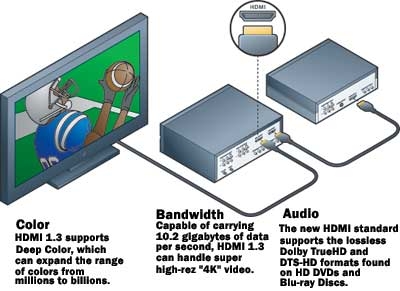HDMI 1.3: The Missing Link Page 2

More Colors
The new HDMI standard also supports something called Deep Color. This feature, which requires that both the source device and the TV be Deep Color-compatible, increases the color bit-depth of images to 30, 36, or 48 bits. (The current version of HDMI, 1.2a, supports only up to 24-bit color, which is the color depth used in broadcast HDTV, DVD, HD DVD, and Blu-ray Disc.) According to HDMI Licensing, Deep Color can deliver pictures with better-defined colors and smoother gradations by expanding the range of possible colors displayed onscreen from millions to billions. Deep Color should benefit contrast too, since the increase in color bit-depth will also boost the range of gray tones between black and white.
HDMI 1.3 also makes possible the introduction of video sources and TVs that conform to the new "xvYCC" color standard. The current color standards for encoding and displaying NTSC and ATSC (high-def) video were formulated around the capabilities of now-dated CRT (cathode-ray tube) technology. But xvYCC, an extended "color space" capable of rendering nearly twice as many colors as the current standards, was created to take advantage of the wider color display range offered by new technologies such as LED-backlit LCD and laser-driven DLP TVs. It's difficult to predict when programs encoded in the new color space will catch on, but TV giants Sony and Mitsubishi have already displayed prototype xvYCC-capable sets.
HDMI Goes Mini
One advantage HDMI could claim over DVI (Digital Visual Interface), the digital video connection that preceded it, was that its jack was considerably more compact. But HDMI 1.3 makes even smaller jacks possible. The new HDMI mini-connector is meant for hooking up portable gear such as camcorders and digital cameras to HDTVs. Sony and other companies have already started to put regular HDMI jacks on high-def camcorders, so mini HDMI models shouldn't be far behind.
Unlimited Audio
One key feature has been missing from the handful of first-gen HD DVD and Blu-ray Disc players: the ability to pass Dolby TrueHD and DTS-HD Master Audio bitstreams to an external surround-sound processor or receiver for decoding. But with HDMI 1.3, these limitations disappear. (Current Toshiba HD DVD players with the company's v2.0 firmware update can decode Dolby TrueHD soundtracks internally and output them as a multichannel PCM signal via HDMI, while first-gen Blu-ray players can't decode either Dolby TrueHD or DTS-HD Master Audio.) With manufacturers of high-def disc players apparently picking and choosing support for built-in decoding of these new high-rez formats in their machines, HDMI 1.3's ability to deliver the native bitstreams from a disc to a surround-sound processor is a welcome development.
In Sync
Remember those old Godzilla movies where there was a lag between the actors' moving mouths and the badly dubbed dialogue? One problem HDTV viewers have had cause to complain about is timing slips between the picture and sound on their systems. This mostly happens when the video signal is sent to the TV on one connection and the audio travels on another, such as when Dolby Digital is sent from a high-def cable box to a receiver. HDMI 1.3's automatic lip-sync timing compensation feature aims to address this problem. How well it works remains to be seen, but if the original Godzilla ever comes out on Blu-ray, I'll expect the dialogue to sync up with the picture. Regardless, HDMI 1.3 is a great new standard.
- Log in or register to post comments



































































